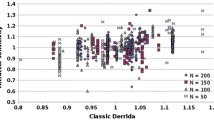Abstract
Most studies of motifs of biological regulatory networks focus on the analysis of asymptotical behaviours (attractors, and even often only stable states), but transient properties are rarely addressed. In the line of our previous study devoted to isolated circuits (Remy et al. in Bioinformatics (Oxford, England) 19(Suppl. 2):172–178, 2003), we consider chorded circuits, that are motifs made of an elementary positive or negative circuit with a chord, possibly a self-loop. We provide detailed descriptions of the boolean dynamics of chorded circuits versus isolated circuits, under the synchronous and asynchronous updating schemes within the logical formalism. To this end, we address the description of the trajectories in the dynamics of isolated circuits with coding techniques and adapt them for chorded circuits. The use of the logical modeling gives access to mathematical tools (group actions, analysis of recurrent sequences, coding of trajectories, specific abacus...) allowing complete analytical analysis of basic yet important motifs. In particular, we show that whatever the chosen updating rule, the dynamics depends on a small number of parameters.





Similar content being viewed by others
References
Alon U (2007) Network motifs: theory and experimental approaches. Nat Rev Genetics 8(6):450–61
Baëza M, Viala S, Heim M, Dard A, Hudry B, Duffraisse M, Rogulja-Ortmann A, Brun C, Merabet S (2015) Inhibitory activities of short linear motifs underlie Hox interactome specificity in vivo. eLife 4:e06034
Bang-Jensen J, Gutin G (2008) Digraphs, theory, algorithms, applications. Springer, Berlin
Bérenguier D, Chaouiya C, Monteiro P T, Naldi A, Remy E, Thieffry D, Tichit L (2013) Dynamical modeling and analysis of large cellular regulatory networks. Chaos (Woodbury, N.Y.) 23(2):025114
Comet J-P, Noual M, Richard A, Aracena J, Calzone L, Demongeot J, Kaufman M, Naldi A, Snoussi EH, Thieffry D (2013) On circuit functionality in Boolean networks. Bull Math Biol 75(6):906–19
Glass L (1975) Classification of biological networks by their qualitative dynamics. J Theor Biol 54(1):85–107
Hansen T, Mullen GL (1992) Primitive polynomials over finite fields. Math Comput 59(200):639–643
Lang S (1997) Algebra. Addison-we edition, Boston
Lidl R, Niederreiter H (1986) Introduction to finite fields and their applications
Remy É, Ruet P (2006) On differentiation and homeostatic behaviours of Boolean dynamical systems, vol 4230. LNBI
Remy É, Mossé B, Chaouiya C, Thieffry D (2003) A description of dynamical graphs associated to elementary regulatory circuits. Bioinformatics (Oxford, England) 19(Suppl. 2):172–178
Remy É, Mossé B, Thieffry D (2016) Boolean dynamics of compound regulatory circuits. In: Rogato A, Guarracino M, Zazzu V (eds) Dynamics of mathematical models in biology bringing mathematics to life. Springer, Berlin, pp 43–53
Robert F (1986) Discrete iterations. Springer, Berlin
Shih MH, Dong JL (2005) A combinatorial analogue of the Jacobian problem in automata networks. Adv Appl Math 34(1):30–46
Snoussi EH, Thomas R (1993) Logical identification of all steady states: the concept of feedback loop characteristic states. Bull Math Biol 55(5):973–991
Thomas R (1981) On the relation between the logical structure of systems and their ability to generate multiple steady states or sustained oscillations. Springer Series Synerget 9:180–193
Thomas R, D’Ari R (1990) Biological feedback
Author information
Authors and Affiliations
Corresponding author
Additional information
Publisher's Note
Springer Nature remains neutral with regard to jurisdictional claims in published maps and institutional affiliations.
Appendix
Appendix
1.1 A. Hierarchical Transition Graph of Circuits and Chorded Circuits: A Compressed Representation of the Asynchronous Dynamics
When possible, it is useful to generate the hierarchical transition graph (HTG), a compressed representation of the dynamics (Bérenguier et al. 2013). It provides a large scale vision of the trajectories, emphazing the main switches and cyclical behaviours, and loosing the detailed information of the STG. Its construction is in the same vein as the strongly connected component graph, for which each node represents all the nodes of the STG belonging to a same complex strongly connected component (SCC). But asynchronous STGs generated from biological networks used to contain many “single SCCs” (i.e. composed of only one element) and the SCC graph remains large. The HTG compresses further the graph by gathering all the single SCCs leading to the same complex SCCs and attractors. There is an edge between two nodes \(H_1\) and \(H_2\) of the HTG if and only if there exists an edge in the STG between an element of \(H_1\) and an element of \(H_2\) (see Bérenguier et al. 2013 for more details). Thus, HTG provides an efficient compressed visualisation of the STG, and thereby emphasizes the main structure and key decision points of the dynamics.
In the case of circuits and chorded circuits, the structure of the HTG can be easily achieved by the description of the asynchronous graph; significant examples are shown in Fig. 6.
Regulatory graphs and their asynchronous dynamics, with and rules for chorded circuits. From left to right: regulatory graph; state transition graph (STG), and hierarchical transition graph (HTG, compression of STG; cf Appendix A). Terms “cc” and “i” stand for cyclic and irreversible components, respectively, while the number written after “#” corresponds to the number of states encompassed by the component. I A4-components positive isolated circuit; II a coherent positive chorded circuit; III an incoherent chorded circuit; IV a positive circuit with a coherent self-regulation. Nodes of the STG of the same color are gathered in the same node of the corresponding HTG
Rights and permissions
About this article
Cite this article
Mossé, B., Remy, É. A Combinatorial Exploration of Boolean Dynamics Generated by Isolated and Chorded Circuits. Acta Biotheor 68, 87–117 (2020). https://doi.org/10.1007/s10441-019-09355-x
Received:
Accepted:
Published:
Issue Date:
DOI: https://doi.org/10.1007/s10441-019-09355-x





